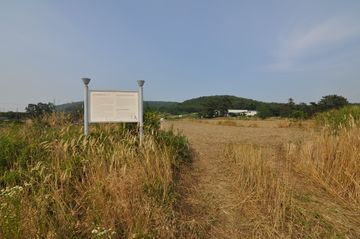경주 화산리 회유토기 요지
| 경주 화산리 회유토기 요지 Ash-glazed Pottery Kiln Site in Hwasan-ri, Gyeongju |
|
 경주 화산리 회유토기 요지, 국가문화유산포털, 문화재청. |
|
| 대표명칭 | 경주 화산리 회유토기 요지 |
|---|---|
| 영문명칭 | Ash-glazed Pottery Kiln Site in Hwasan-ri, Gyeongju |
| 한자 | 慶州 花山里 灰釉土器 窯址 |
| 주소 | 경북 경주시 천북면 화산리 942-1번지 |
| 지정(등록) 종목 | 사적 제241호 |
| 지정(등록)일 | 1974년 12월 14일 |
| 분류 | 유적건조물/산업생산/요업/토기가마 |
| 시대 | 통일신라 |
| 수량/면적 | 10,800㎡ |
| 웹사이트 | 경주 화산리 회유토기 요지, 국가문화유산포털, 문화재청. |
|
|
|
해설문
국문
요지는 자기나 토기, 기와 등을 굽던 가마터를 말한다. 이곳 가마터 주변에는 버려진 토기 파편들이 많이 흩어져 있고, 재가 쌓여 흑색으로 변한 토층과 붉게 탄 적색토층이 군데군데 확인된다.
발견되는 토기들은 다양한 꽃무늬를 도장처럼 찍어 만든 인화문(印花文) 토기로, 20% 정도가 회색유약을 바른 토기들이다. 토기의 모양은 술잔, 사발, 병 등 여러 종류가 있으며, 대형 항아리와 넓적하고 작은 뚜껑달린 그릇 조각들도 발견된다. 기와·벽돌 조각도 있어서 같이 생산한 듯 하지만, 그 수량은 적은 편이다.
이곳 가마의 사용 시기는 7세기 말부터 9세기 중반 경까지로 보인다. 통일신라 전기에 경주지역에 사용된 토기들이 주로 이 지역에서 만들어졌음을 알 수 있다. 토기의 종류나 형태가 다양하고 화려해서 이때가 인화문 토기의 전성기로 볼 수 있다.
특히 회색유약을 바른 토기들은 발전된 단계의 것으로 우수한 토기제작술을 보여준다. 회색유약 기법이 바탕이 되어 청자(靑瓷)가 만들어지기 때문에 회유토기는 우리나라 도자기 제작기술 발전의 중요한 단계를 보여준다.
영문
Ash-glazed Pottery Kiln Site in Hwasan-ri, Gyeongju
This is the site of kilns where earthenware was produced during the Unified Silla period (668-935) from the end of the 7th century to the middle of the 9th century.
Shards of earthenware were found scattered around the vicinity of the kiln site. The excavated earthenware included liquor cups, bowls, and bottles, as well as a large jar and a small, wide lidded bowl. A small number of roof tiles and bricks were also found. Most of the earthenware was stamped with diverse flower designs, and around 20 percent was glazed with ash. This ash glazing demonstrates an advanced pottery-making technique upon which the popular Goryeo celadon would later be produced.
It is presumed that most of the pottery used in the Gyeongju area during the early Unified Silla period was made at these kilns. The earthenware found here is ornate and of diverse shapes, suggesting that this period was the peak in popularity of stamped flower design earthenware.